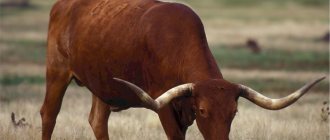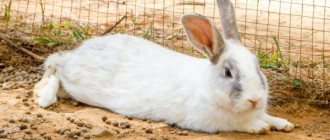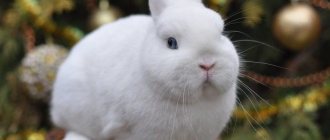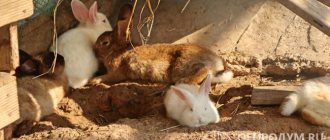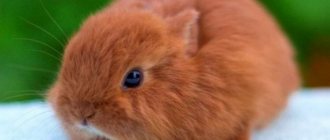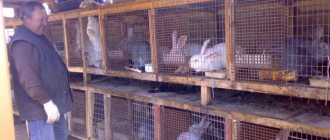Expert opinion
Dobryshev Sergey Anatolievich
Professional rabbit breeder and hare breeder with 30 years of experience
The wild or otherwise European rabbit has the honorable title of being the ancestor of all existing breeds, including decorative ones. In the process of evolution, their physiology has adapted to survive in very difficult conditions. Wild rabbits survive successfully despite infectious diseases, predators and other difficulties. Getting to know their characteristics and lifestyle helps to better understand the nature of domestic representatives, what they need, and proper care for them.
Appearance
A wild rabbit is a small animal with a body length of up to 45 cm and a weight of up to 2.5 kg. A characteristic feature of the animal is that the length of its ears is always less than the size of its head, up to 7 cm, in contrast to hares, whose ears are longer. The feet of the rabbit's limbs are covered with short hair. The paws have long and straight claws.
The coat color of wild rabbits is predominantly gray-brown; in some individuals the reddish shade of guard hair predominates. The hair on the central part of the back is slightly darkened, the tail at the end is also dark, almost black or gray, and white underneath. The fur on the sides of the body is always slightly lighter than on the back, and in the abdominal area it is white or light gray. On the back of the head, behind the ears of the animal, there are ocher spots.
The fur of a wild rabbit does not change color during seasonal molting, which occurs in autumn and spring.
Where do rabbits live in the wild?
Wild European rabbits are native to Southern Europe, where they get their name. Over time, their habitat expanded significantly. The largest number of species lives in North America. In second place are the countries of South America. Wild rabbits live in Africa, western and central Europe, Scandinavian countries, the Mediterranean, islands in the Pacific Ocean, and the Atlantic. They feel good in Australia and New Zealand, where there is a favorable climate in the summer, there are no droughts, and in the winter there is no snow cover.
Animals choose places with dense vegetation for their habitat. They settle in meadows, clearings with tall grass, and along ravines. Plants within reach serve as food for them. They prefer light soil because they have to dig their own holes.
The limit of the habitat of wild rabbits in the world
Wild rabbits, as a rule, choose to live in areas with temperate climatic conditions, where there are no harsh winters. Today, these animals are distributed throughout the planet, with the exception of the Arctic and Antarctic regions.
The border of habitat in Russia
Rabbits appeared in Russia a very long time ago. They are even mentioned in ancient chronicles, which say that the first animals were released onto the coastal territory of the Dniester and Dnieper, from where the long-eared animals migrated to the north and east of the country.
At the moment, large populations of wild rabbits have been registered in the North Caucasus, in the Stavropol and Krasnodar Territories, and the Rostov Region. The climate and natural conditions of these regions are ideal for the animals, and they successfully reproduce there.
Spreading
The wild rabbit was originally found in the Iberian Peninsula, as well as parts of France and northwest Africa. It is believed that in this area, characterized by a warm climate, animals were able to survive after the Ice Age. From here, thanks to the Romans, European rabbits came to the Mediterranean. Animals were brought to the territory of modern England and Ireland by the inhabitants of Scandinavia in the 12th century AD. During the Middle Ages, rabbits had already spread throughout Europe.
In the 18th and 19th centuries, wild rabbits were specially transported to different islands - Hawaiian, Canary, Azores, and released there for acclimatization and reproduction. The animal colonies were supposed to serve as food for sailors. Towards the middle of the 18th century, long-eared rodents were brought to the territory of Chile, from where the animals independently moved to Argentina. Somewhat later, in the mid-20th century, European rabbits were brought to Australia, the USA and New Zealand.
The European rabbit lives wherever there are no harsh winters
At the moment, wild rabbits live wherever there are no harsh winters. These animals are not found except in Antarctica and Asia.
Reference. Wild rabbits choose habitats where in winter the number of days with stable snow cover does not exceed 37.
Two types of burrows in rabbits
The dwellings of wild rabbits are of two types: simple and complex. Simple ones are disposable and are pulled out by pregnant females before giving birth, following instinct. There births and feeding of newborns with mother's milk take place.
A simple burrow, which is a tunnel with a diameter of 10-15 cm at the entrance, gradually widens and ends with a chamber intended for brood, with a diameter of 30-60 cm.
Families led by a dominant male live in complex, permanent burrows.
The family hole is complex. The length of the tunnels reaches 50 meters. There are numerous branches and several emergency exits. The height of the living quarters is 30-60 cm. You can detect the hole by the vegetation eaten around it.
Lifestyle
The European rabbit leads a sedentary lifestyle, unlike the hare. Animals inhabit territories with rugged terrain and rich vegetation, since the latter serves as food for them. Animals can be found on the coasts of estuaries, in ravines, and ravines. Animals are not found in dense forests, nor in mountainous areas.
Wild rabbits often coexist with humans, populating areas on the outskirts of populated areas, landfills and wastelands. Since rodents have a need to dig holes, the composition of the soil matters to them. For these animals, loose soil is preferable to clay or rocky soil. Having chosen a territory, the animals mark it with their secretions, rub their muzzles on objects, scatter excrement and splash urine. These animals prefer to live in small groups in which:
- the dominant role is given to the breeding male;
- a dominant female with cubs lives with him;
- the group includes 1-2 more females with or without offspring, living in separate burrows.
Young males living in the same colony with the dominant one readily protect females and offspring. Rabbits have their own methods of communication, they warn each other about danger, and come to each other's aid.
Wild rabbits are polygamous creatures, but some individuals create a family with one female and remain with her forever.
The burrows of wild rabbits are of interest. They are different:
- Family. Only adult animals live in them. Such dwellings are equipped with several entrances and exits.
- Broods. This type of burrow is intended for baby rabbits. Fled females independently dig them not far from the family burrow. Brood burrows have only 1 entrance, which also serves as an exit. Female rabbits come there to feed their babies. When leaving the nest, the female disguises the entrance so that wild animals do not find the offspring.
Family-type burrows can be simple or complex. The first are intended for single females, and the second for a dominant male with his family. Simple family burrows have up to 3 entrances and exits, and complex ones have up to 8.
Nutritional Features
Wild rabbits are herbivores, adapted to life in regions with poor vegetation. Animals digest food with the help of cecotrophs, which contain many enzymes, amino acids, vitamins and beneficial bacteria.
They are formed in the cecum and, after exiting through the anus, are eaten, enter the intestinal canal and participate in the breakdown of cellulose.
In summer, European rabbits eat grass and leaves. In winter, their diet consists of branches and roots. European wild rabbits that live near farmers' fields feast on carrots, lettuce, cabbage, legumes and grains.
What do they eat?
When feeding, a wild rabbit does not move further than one hundred meters from the hole. Therefore, his diet is not particularly varied. Only winter and summer nutrition differ. During the warm season, small animals eat leaves and grass. If there are fields and vegetable gardens near their home, then these animals eat salads, cabbage, all kinds of root vegetables and grain crops.
As cold weather approaches, rabbits switch to dry grass and plant parts dug out of the ground. In addition, in winter they can also feed on shoots and bark of trees or shrubs.
Varieties of European rabbit
The European wild rabbit is the only representative of the domesticated rabbit from which modern breeds originated. The following species are found in the wild:
An ordinary rabbit. It lives in most European countries and other areas, with the exception of places with prolonged sub-zero temperatures.
The water rabbit is the largest representative of the genus. The length of the body reaches 55 cm. It is notable for the fact that it swims well and knows how to hide from pursuit under water. In this case, the nose remains on the surface, which allows the animal to remain in this position for a long time. They live in the southeastern states of the USA. Swampy lowlands are chosen for living.
Red rabbit. Habitat: highlands in southern Africa. A distinctive feature is the thin silky fur of a reddish color, tinged with gray. Long body, large ears covered with sparse hair.
The Idaho rabbit (pygmy) is the smallest rabbit in the world. Body length from 22 to 28 cm, weight 250-450 grams. Short hind limbs make it impossible to move by jumping, as its brothers do. The fur is yellowish-brown, lighter on the belly and paws. Lives in the northwestern states of the USA. It settles mainly in wormwood thickets, which is the main type of food.
Nutalla is a small animal. The body length is 33-40 cm. It has long hind limbs, the feet of which are covered with long hair. The main color is light brown. Lives in the USA and Canada.
California rabbit. The large animal reaches 50 cm in length. The legs, paws, ears, and tail are short. Color ranges from brown to dark brown. Lives on the Pacific coast of North America. Settles in areas overgrown with bushes. A distinctive feature is the ability to climb bushes and small trees in search of food.
Steppe rabbit. A characteristic external feature is large, vertical ears. With a body size of 33-43 cm, the length of the ears can reach 10 cm. The color is grayish-brown. Habitat: desert grasslands of North America and Mexico. They feed on cacti and herbs growing there.
Tailless or volcanic rabbit. One of the smallest species of wild rabbits. Body length 27-32 cm. Small rounded ears, tail almost invisible. Habitat: mountainous areas of central Mexico.
The most widespread is the common rabbit.
Lifespan of wild rabbits
The biological age of rabbits living in the wild is 15 years, but in reality only 30% of rabbits survive until the age of three. This is due to the fact that there are a lot of predators and birds who want to hunt these defenseless animals. But the cause of early deaths is not only attacks from wild animals, but also various infections and diseases that a weak body cannot tolerate.
To date, the maximum recorded age for rodent life expectancy is 19 years. In the wild, rabbits do not live more than 2-3 years, which cannot be said about pets, whose life is completely dependent on their owner. Domestic rabbits can live up to 7 years.
How does reproduction occur?
These small animals are considered very prolific. They breed almost all year round. Female rabbits can bear offspring about three times per season. Pregnancy in these animals lasts approximately one month. The number of rabbits in a litter can vary from 4 to 12 and depends on the living conditions and the age of their mother. Thus, in a year she can produce from 20 to 50 cubs. Within a few hours after giving birth, the female is again ready for mating.
Rabbits of this species grow at a rapid pace due to the fact that the very first four weeks after their birth they feed only on their mother’s milk. After five months, they reach puberty and leave the family, forming their own.
What is the value of these animals for humans?
It turns out that only this species of European wild rabbit has been domesticated by humans. Therefore, he is considered the ancestor of all domestic breeds of these small animals without exception.
They are currently being bred in various natural protected areas and nurseries. European rabbits are in demand among many breeders, as they can be used to improve breeds of domesticated species.
In addition, they are a commercial object due to their beautiful fur and tasty meat. That is why rabbit breeding is considered one of the most important branches of world agriculture.
Since the domestication of wild rabbits, more than seventy different breeds of these animals have been bred. Among them are downy, decorative, and also those used for testing new medications and food products in scientific laboratories.
But besides being useful, these wild animals in some countries, where there are no predatory animals, can cause great harm to people, eating all crops, damaging fields, crops, and also spoiling land with their numerous burrows. For example, on the Pacific islands they completely destroyed vegetation, which led to soil erosion and the destruction of coastlines that served as nesting sites for seabirds.
Home for small animals
Such tunnels can be seen in any open area with difficult terrain; this is where the wild rabbit digs them. Where this small animal lives, only sandy soil predominates, so that it is easier and more convenient for him to dig holes for himself.
Harsh survival conditions forced these animals to hide as deep underground as possible, where they could hide away from predators. There they spend most of their lives. Such burrows are mainly dug by females, and this takes a lot of time. They look like nesting areas with three exits to the surface.
